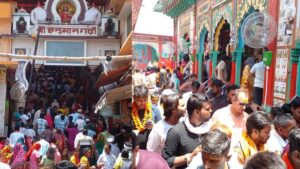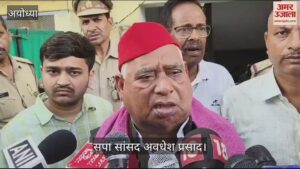
The idol of the Lord seated on the swing in the Shri Ram Janmabhoomi complex.
Ayodhya. The rich tradition of Sawan Jhoolnotsav has been going on for centuries in Ramnagari. Here in Sawan, the idols of Mata Janaki along with Lord Shri Ram are placed on swings in hundreds of temples. In some temples, the tradition of Jhoolnotsav is different from this. Where Bharat, Laxman and Shatrughan are also placed on swings along with Lord Shri Ram and Mata Janaki. Among such temples, Shri Ramlala, Dashrathmahal, Rangmahal and Rajgopal are famous.
The court of Ramlala established in Shri Ram Janmabhoomi is also buzzing with Jhoolanotsav. Lord Shri Ramlala seated on a silver swing is swinging every day. On this occasion, a gathering of songs and music is also being organized. Acharya Satyendra Das, the chief priest of Shri Ramlala, says that there is a special tradition of Jhoolanotsav in the court of Ramlala. Here, along with Shri Ram, Bharat, Laxman and Shatrughna are also seated on the swing and swung. On Sunday, 1.50 lakh devotees attended the court of Ramlala.
Rangmahal, one of the ancient temples of Ramkot, also has a special tradition of Jhoolnotsav. This tradition of Rangmahal has been flowing since the time of Swami Saryu Sharan, who was one of the Siddha saints of Ramnagari. Compared to other temples, there are four swings here. On one swing are Ram-Janaki, on the other are Bharat-Mandavi, Laxman-Urmila and Shatrughan-Shrutikirti. Mahant Ramsharan Das of Rangmahal tells that Lord Shri Ram along with all the four brothers and their wives are inseparable from Lord Ram and Sita because of being complementary and close to power. To confirm this inseparability, four swings are set up in the month of Saavan and everyone is made to swing. The grand cultural evening adds to the grandeur of the festival. In Rajgopal temple also, there is a tradition of celebrating Jhoolnotsav by placing Lord Shri Ram along with all the four brothers and Mother Sita on the swing.
Eight idols are placed on the swing
It is believed about Dashrath Mahal that during Treta Yug, King Dashrath’s palace was here. Lord Shri Ramlala spent his childhood in this palace. About 300 years ago, this heritage of Treta Yug was reestablished by the great saint Ramprasadacharya. It is said that Mata Kishori herself applied Tilak on Baba Ramprasadacharya with her own hands, which remained indelible for life. The origin of Bindu sect is also believed to have been from here. In accordance with the heritage of Dashrath Mahal, the service of the Lord here is done with full royal splendor. The beauty of Dashrath Mahal is extremely captivating in the month of Sawan. The Mahant of the temple, Bindugadcharya Swami Devendraprasadcharya, tells that eight idols of Lord Ram, his four brothers and their wives are installed on the swing studded with gold and silver. Along with this, a cultural evening is organized in front of them every evening.


